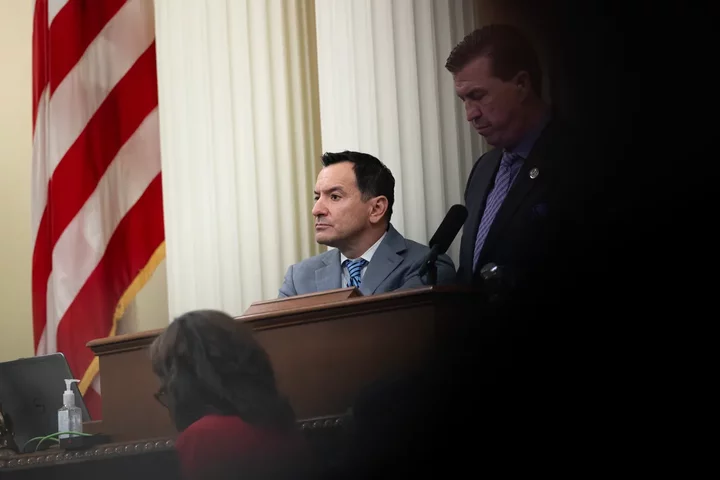Former speaker of the Assembly Anthony Rendon at the dais on May 31, 2022. Photo by Miguel Gutierrez Jr., CalMatters
###
This story was originally published by CalMatters. Sign up for their newsletters.
###
As California intensifies its fight with the Trump Administration, the race for the state’s top schools job is becoming ever more crowded.
Today, former Assembly Speaker Anthony Rendon formally entered the race to succeed Tony Thurmond as State Superintendent of Public Instruction. He joins a host of other state lawmakers and local school board members vying to replace Thurmond, who terms out in 2026 after eight years on the job.
The next state superintendent faces daunting challenges. The most urgent priority may be responding to President Donald Trump’s funding cuts and policy shifts, including the dismantling of the U.S. Department of Education and increased immigration enforcement. Those policies will have a deep impact on thousands of California’s 5.8 million K-12 students, at least 20% of whom have at least one parent who lacks legal status, according to the Children’s Partnership, a policy and advocacy nonprofit.
“There’s no question the Trump administration is going to continue to weaponize K-12 education,” said Morgan Polikoff, an education professor at the University of Southern California. “The state superintendent can serve as a buffer, helping districts navigate funding cuts and policy changes while continuing to push against the Trump administration. It’s important that California keeps fighting.”
From the classroom to the Legislature
Rendon, a Democrat from Lakewood, spent 12 years in the Legislature, the last eight as speaker. While he was speaker, the state nearly doubled its K-12 funding and introduced a new grade, transitional kindergarten – a particular priority for Rendon, who started his career as an early education administrator.
A former UC regent, Rendon said he’d try to protect California schools from Trump’s policies, particularly those related to immigration, but also work at the state level to advocate for more funding and accountability.
“California has the best public universities in the world,” Rendon said. “We need to have the best K-12 schools in the world, too.”
Vague job duties
California has a murky hierarchy when it comes to schools. The governor, Legislature, State Board of Education and superintendent all share duties, but the superintendent has the least amount of power. The superintendent oversees the California Department of Education, but California also has a system of local control, which means local school boards have plenty of latitude over day-to-day operations. Superintendents often find themselves balancing the needs of at least a dozen stakeholders, with not much power themselves.
In 2023, a bill by former Assemblymember Kevin McCarty would have banned state superintendent elections altogether, turning the position into a governor-appointed role, like it is in 41 other states.
Still, despite very limited authority, state superintendent can be an important job, said Julie Marsh, a professor at USC and executive faculty director for Policy Analysis for California Education, a research center. Despite the obstacles, the state superintendent oversees the largest, most complex school system in the U.S. and has a wide platform to “do something good.”
“They can’t create policy, but they can help set the agenda. They can use their bully pulpit to defend the policies and values that Californians overwhelmingly support,” Marsh said.
Muratsuchi jumps in
Assemblymember Al Muratsuchi, chair of the Assembly education committee, is also running for superintendent. An adjunct professor at El Camino Community College and former school board president at Torrance Unified, Muratsuchi has a long history of advocating for schools.
He’s authored numerous school bills, including AB 49, which would make it harder for immigration agents to enter schools, and AB 477, which would increase state education funding and raise salaries for teachers and other school staff. He was also the lead author of Proposition 2, a $10 billion school facilities bond that passed last year.
As state superintendent, Muratsushi said he’d continue to push for more funding while standing up to the Trump administration.
“As California’s top elected education leader, the state superintendent should have a strong record of fighting Trump’s attacks on public education and our most vulnerable students,” said Muratsuchi, a Democrat from Torrance. “I believe I’m that person.”
Newman enters race
Muratuchi’s former counterpart in the state Senate is also running for superintendent. Josh Newman, a Democrat from Fullerton who served as chair of the Senate education committee from 2023-24, said that in addition to fighting Trump he’d focus on students’ physical and mental health, boosting civics education and revitalizing the Department of Education.
Accountability and compliance should be a priority, he said.
“We’ve increased funding substantially in California for 20 years, yet we haven’t seen a corresponding increase in test scores or a narrowing of the achievement gap,” Newman said.
“That points to a systemic issue where the superintendent and Department of Education must play a bigger role.”
Shaw looks beyond Chino
Sonja Shaw, president of the Chino Valley school board, made national headlines for her attempts to require school staff to notify parents if a student identifies as transgender. Thurmond actually attended a Chino Valley board meeting to oppose the measure, and she had police escort him out.
Now, Shaw is running for Thurmond’s job, saying she wants to take her fight statewide.
“Parents want schools to focus on reading, writing and math, not social justice and LGBTQ ideology,” said Shaw, a Republican. “I feel like we can take this fight beyond Chino.”
Several other candidates have also filed initial paperwork with the Secretary of State, including two members of the Los Angeles Community College District: Nichelle Henderson and Andra Hoffman.
The state superintendent position pays $194,587 annually.

CLICK TO MANAGE